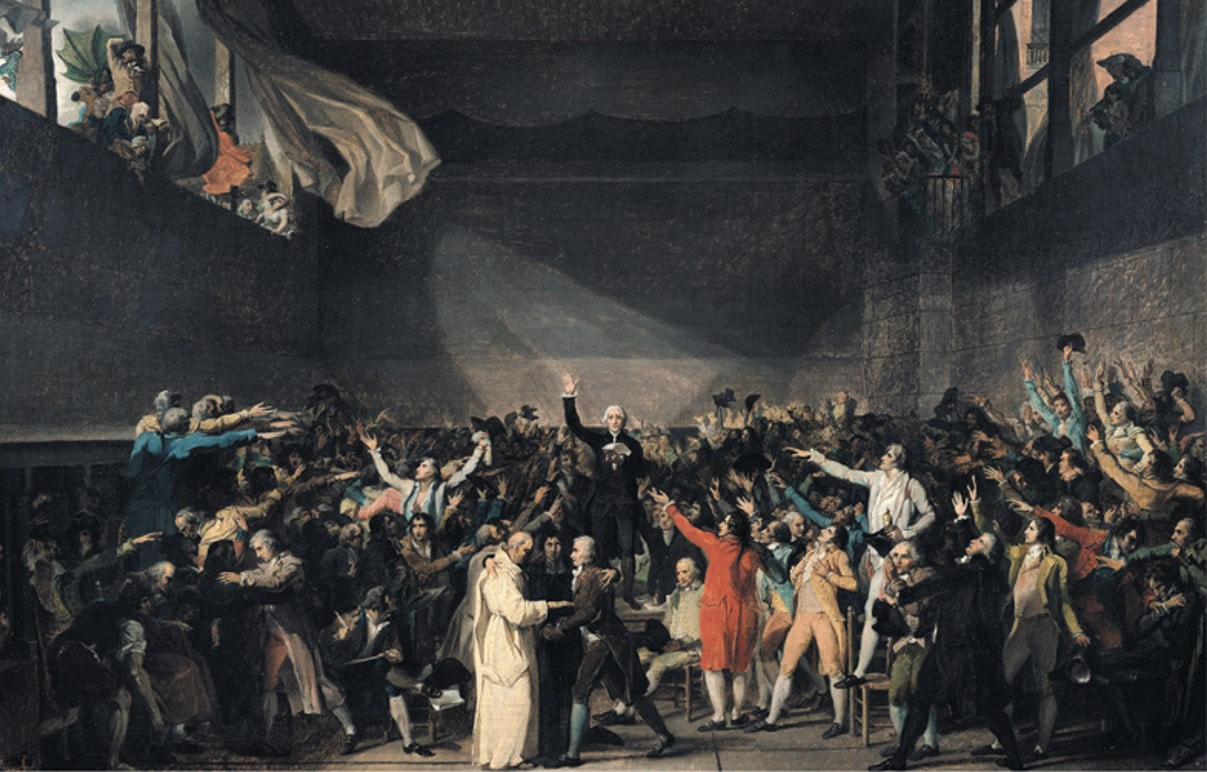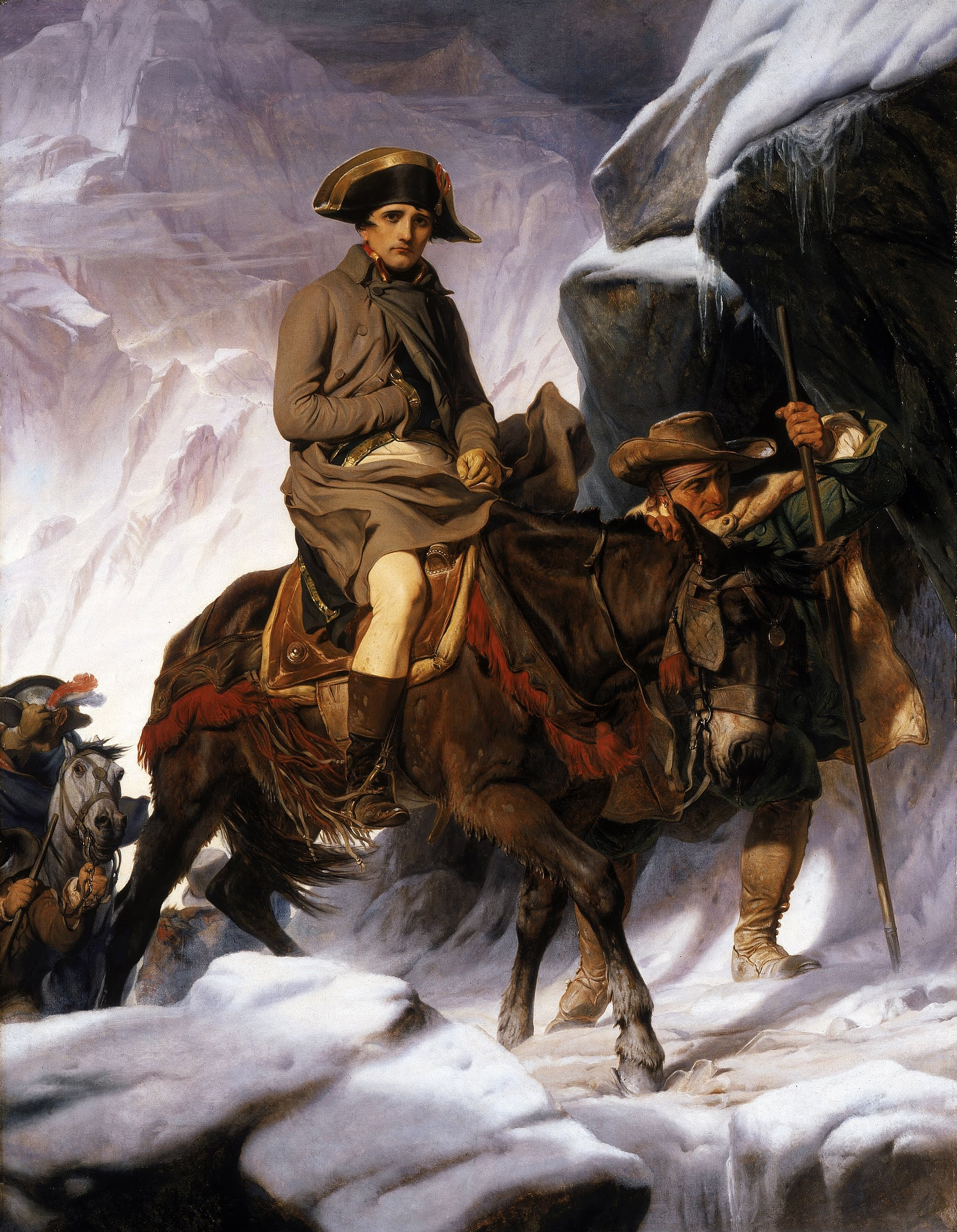Napoleonic Art
That's great! You chose to examine my art! I'm so glad you did! Well, firstly, you've probably seen the above picture before, right? That's me crossing the Alps Mountains in one of my many military campaigns. And we'll talk about that picture a bit later. But for now, let's introduce you to a new style of art: neoclassicism.
(Well, hold on, side note. I didn't technically "create" this art movement, but neoclassic art is very common from the periods between ~1750 and 1848. And since I'm the biggest "thing" to happen during that time period, yeah, it's associated with me. Ok. Back to the tour...)
Neoclassical art coincides with (...or, really, it starts BECAUSE of...) the European discovery of Pompeii and Herculaneum in the early 1700s. You know Pompeii, right? With that giant volcano called Vesuvius that exploded almost 2,000 years ago and covered (...and perfectly preserved...) the city of Pompeii? I wasn't there, but the ordered excavation by world powers and the ensuing "spreading around" of statues, preserved art, and of course, hand drawn inspirations like the one below, really inspire Europeans to "go back" to the "classics". Yes. Again... Like they did in the Renaissance. But hey, that's why it's call "neoclassicism": "new", yet, "classic".
Before we get too far, let's remember the art movements we've seen:
- Renaissance
- --> Mannerist
- -->Baroque
- --> Rococo --> and finally
- --> Neoclassicism. Look below: can you see how the Virgin Mary is shown in all five art phases?
See how neoclassical art looks a lot like Renaissance art, just more vibrant? But remember what made a Renaissance painting, "Renaissance": portrait, pose, proportion, perspective, ...and of course, pride. That bottom-right painting, above? That's called St. Roch Asking the Virgin Mary to Heal Victims of the Plague, painted in 1780, by Jacques-Louis David. Write that name down: he's the most famous neoclassical painter of the period, and perhaps, of all time! But look at the painting below. Can you see the perspective? the balance? the mathematical proportion? the "vanishing points"? Remember those: those are the ones that tell your eyes where to look! And David was the master of it!
You don't know this yet, but your teacher has been showing you neoclassical art this entire unit (look at the first image, below)
Using your understanding of what made Renaissance art, "Renaissance art", and knowing that neoclassicism is kinda just a "revival" of it, examine the images below, and be prepared to tell your partner WHY this is neoclassical art:
Using your understanding of what made Renaissance art, "Renaissance art", and knowing that neoclassicism is kinda just a "revival" of it, examine the images below, and be prepared to tell your partner WHY this is neoclassical art:
Yep! I threw in an American Revolution painting, too, just for you American students! Cuz yeah, neoclassicism wasn't just contained to the continent.
But let's get back to one of the most famous neoclassic paintings in history: Napoleon Crossing the Alps, by yes, Jacques-Louis David, in 1800. What makes this a neoclassical painting? And how does it really define my legacy? (Need help? Whatever WORDS you use to describe this art...that's me!)
But let's get back to one of the most famous neoclassic paintings in history: Napoleon Crossing the Alps, by yes, Jacques-Louis David, in 1800. What makes this a neoclassical painting? And how does it really define my legacy? (Need help? Whatever WORDS you use to describe this art...that's me!)
And that's it! That's neoclassicism, and that's me! Whatever words with which you describe neoclassical art is me: powerful? emotional? dramatic? violent? BIG? emotional? That's me! I'm glad you came...
...Wait. I guess I have to tell you something.
I'm dead now, so I don't really care what people think about me, so I'll be honest. That above painting, although beautiful, is crap. It's wrong. It's a farce. It's complete fiction.
And I know this. Because that is the painting I want associated with me. But here's the real one. THIS is what it was like to cross the Alps:
...Wait. I guess I have to tell you something.
I'm dead now, so I don't really care what people think about me, so I'll be honest. That above painting, although beautiful, is crap. It's wrong. It's a farce. It's complete fiction.
And I know this. Because that is the painting I want associated with me. But here's the real one. THIS is what it was like to cross the Alps:
This painting above, done in 1850 by artist Paul Delaroche (NOTE: I was dead by 1850...) is more of a realism-style of art. And you can tell. A lot more "real" anguish, emotion, pain...and not much heroism! (Another NOTE: Your teacher will talk about the realism art movement later...) But let's return: What other differences do you see between the two art pieces that depict the SAME event?
I guess, since your teacher assigned this assignment, you should and need to know the WHOLE "me", in art form. You tell me: now knowing that the Delaroche painting is more accurate, what else can you add to my legacy, revealed in art form?











